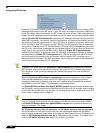
VoIP
518
SonicOS Enhanced 4.0 Administrator Guide
1. Phone B registers with VoIP server - The SonicWALL security appliance builds a
database of the accessible IP phones behind it by monitoring the outgoing VoIP registration
requests. SonicOS translates between phone B’s private IP address and the firewall’s
public IP address used in registration messages. The VoIP server is unaware that phone B
is behind a firewall and has a private IP address—it associates phone B with the firewall’s
public IP address.
2. Phone A initiates a call to phone B - Phone A initiates a call to phone B using a phone
number or alias. When sending this information to the VoIP server, it also provides details
about the media types and formats it can support as well as the corresponding IP
addresses and ports.
3. VoIP Server validates the call request and sends the request to phone B - The VoIP
server sends the call request to the firewall’s public IP address. When it reaches the
firewall, SonicOS validates the source and content of the request. The firewall then
determines phone B’s private IP address.
4. Phone B rings and is answered - When phone B is answered, it returns information to the
VoIP server for the media types and formats it supports as well as the corresponding IP
addresses and ports. SonicOS translates this private IP information to use the firewall’s
public IP address for messages to the VoIP server.
5. VoIP server returns phone B media IP information to phone A - Phone A now has
enough information to begin exchanging media with Phone B. Phone A does not know that
Phone B is behind a firewall, as it was given the public address of the firewall by the VoIP
Server.
6. Phone A and phone B exchange audio/video/data through the VoIP server - Using the
internal database, SonicOS ensures that media comes from only Phone A and is only using
the specific media streams permitted by Phone B.
Local Calls
The following figure shows the sequence of events that occurs during a local VoIP call.


















